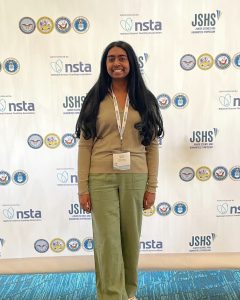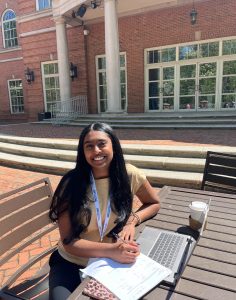Ready, set, science. The Junior Science and Humanities Symposium (JSHS) is a STEM research competition geared toward high schoolers. For the national competition, students prepare and present individual research projects to scientific judges, and a total of $4,500 in scholarships is awarded to the top three finalists.
To reach the national level, one must qualify by finishing within the top five at the regional competition. All students currently taking SPA’s Advanced Science Research (ASR) course applied to attend the regional competition. All students were accepted and traveled to South Dakota in February to compete.
However, to be permitted to attend nationals, one must finish in the top five of their respective region’s oral presenters.
“Certain people got selected for the oral presentation, and I think that’s about the top 24 people,” Meagher said, “The top five oral presenters get to go to nationals, and I finished fourth.”

Junior Shefali Meagher attended nationals from Apr. 22-26 in Washington, D.C., where she gave a poster presentation of her project. Her project started in ASR, and it involved testing the effects of cosmetic toxins on certain characteristics of the amniotic fluid.
Through numerous trials, Meagher was able to conclude that methylparaben has a significant effect on the pH of the amniotic fluid: after introducing the toxin to the fluid, its pH decreased. Amniotic fluid typically has a pH between 7.1-7.3, and any alteration in pH could imply fetal distress or other complications requiring further investigation. Further, she gathered that methylparaben had no significant effects on the fluid’s viscosity or the glucose levels.
Initially, going into the class, she was unsure of what project to pursue. However, she consulted her summer experiences at a fertility clinic for inspiration.
“I interned at a fertility clinic in New York, and that inspired my project because one of the doctors there had been interviewed in an article [about the topic],” Meagher said.
“That isn’t my project, but it’s similar in a way, and that is what inspired me to pursue this,” she said.
In Washington, D.C, Meagher presented her project once to three judges.
“You have three minutes to present, you give your presentation, and they follow up with five minutes of questions,” she said.

Awards are given to the top three finishers in each competing category: biomedical sciences, chemistry, engineering and technology, life and behavioral science, environmental science, math and computer science, medicine and health and physical sciences. Meagher competed in medicine and health; although she didn’t win anything, she felt confident about her presentation.
“I think [my presentation] went as well as it could have gone,” she said.
Although presentations were the conference’s uniting factor, the event encouraged attendees to participate in activities. JSHS, sponsored by the Department of Defense, featured guest speakers such as the Secretary of the Office, the Secretary of Defense, and members of the Navy.
“One night we had trivia night, which was probably one of my favorite things that I did there,” Meagher said.
Looking back on her experiences, Meagher enjoyed her time in the lab, in the classroom and with the people taking ASR. “It’s a lot of work at times, but it teaches you skills that you’re definitely going to need to know if you want to pursue a career in STEM,” she said.